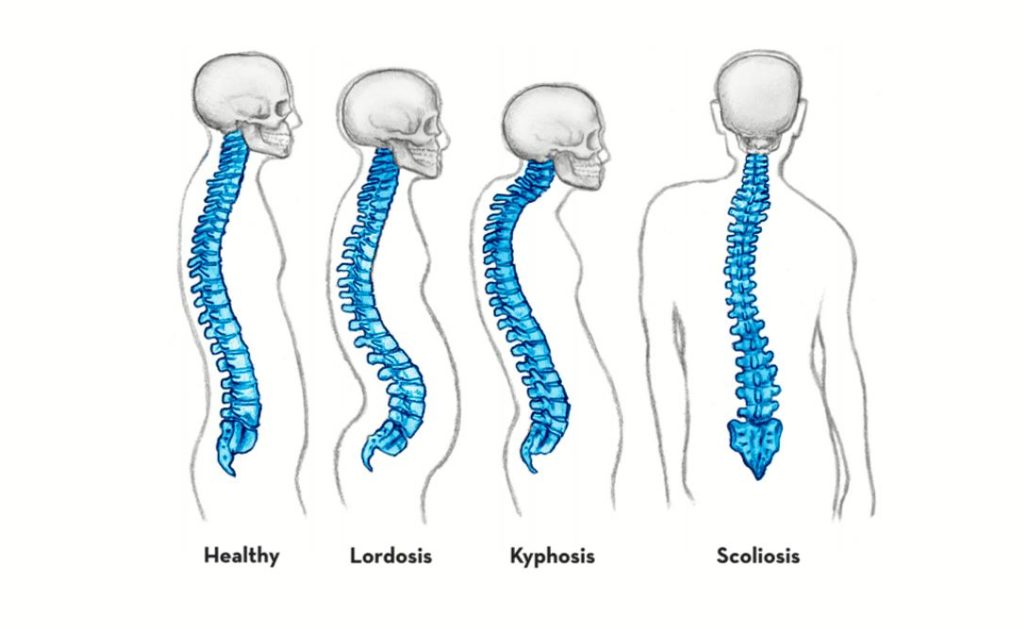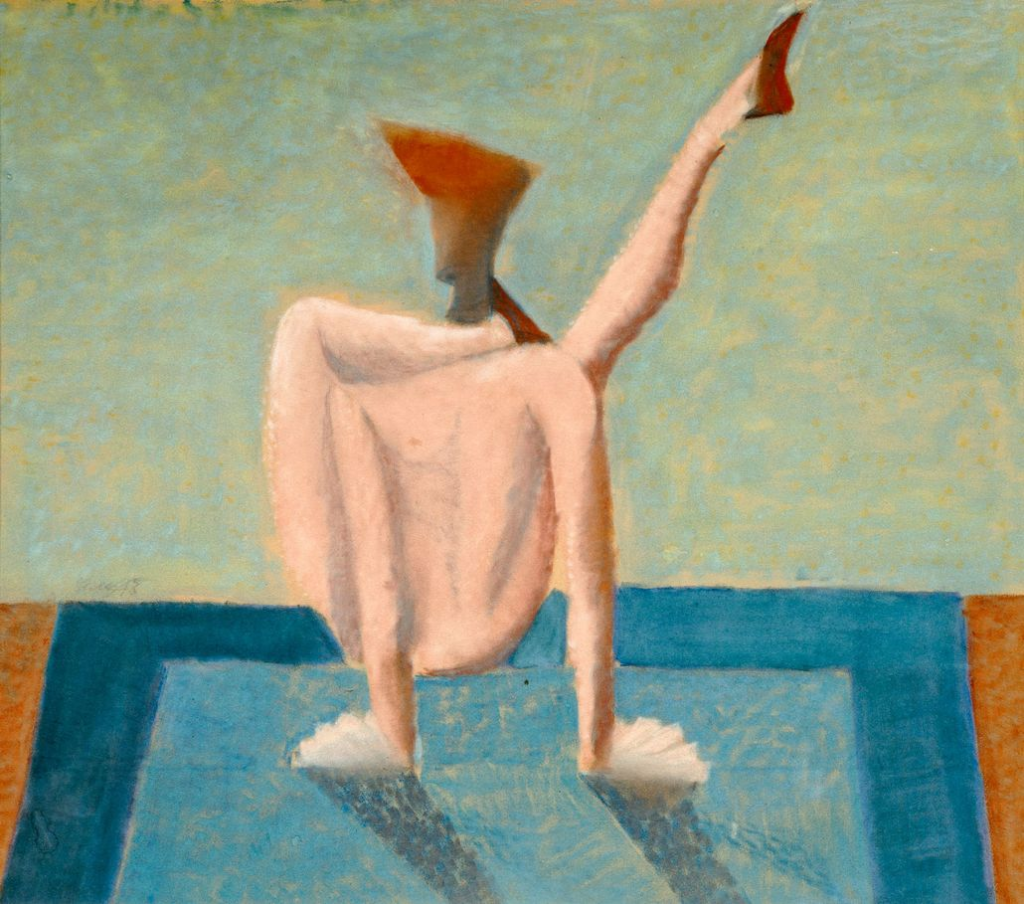Written by: m.wilson
What if bipedalism was a contortion? Humans are one of the only mammals to hold itself upright instead of horizontally, even though it does nothing to improve movements like agility or speed. Perhaps standing up began as an artistic expression, a mating ritual, or a satisfying stretch until everyone started doing it and discovering the benefits. Anthropologists surmise that humans found walking upright helped them to think better, see farther into the distance, and carry tools/children, etc. Nonetheless, the modern human has gained some very valuable skills – but while losing access to other abilities like climbing trees efficiently, and also royally screwing up our spines in a big way.
The spine was stiffer and straighter before the lower back curved into a lordosis shape within the lumbar portion of the back – which balanced the gravity on two legs just right – slightly behind and raised above the hips. However, this balance often ends up lopsided, with 619 million people worldwide currently suffering from lower back pain. At the top of this vertical structure is the cervical area (neck) of the spine, which also curved-in to support a large head without the frequent contraction of the muscles there.
Humans must learn how to assume this posture for walking after birth, since babies have C-shaped spines like chimps and are not bipedal. They always begin life as crawlers while the muscles strengthen and their spines grow out of a horizontal state into the vertical shape. Then later on, as we age and our muscles weaken, (along with the bones), our spines seemingly return to the original weakened state, in a process called Kyphosis – an excessive outward curvature, resulting in a hunched-over walk.
The elderly also experience limitation in movement, become shorter, and encounter a strong likelihood of hip damage as a result of this shift in the spine. Therefore, it’s easy to see why the back is so deserving of our special attention throughout our lives, and as described in the current medical research, stating that maintaining the flexibility of the spine is critical for protecting health and enhancing longevity.
‘The spine is a protective structure for the spinal cord and the nerves that branch out from it. It provides a pathway for communication between the brain and the rest of the body.‘ – Cleveland Clinic
The Spine Affects Everything Our spines affect everything in our bodies, such as the organs, movement, mental health, and eyesight – since the upper cervical spine and proper nerve communication are required to see. When there is any misalignment or dysfunction within this area of the spine, due to its proximity to the cranial nerves and brain stem, neurological functions such as digestion, heart rate, and emotions are also affected.
“It can develop slowly with time or come suddenly and can be a dull, constant ache or a sharp pain.”
PROBLEMS WITH THE BACK

“Research has shown that chronic pain, such as lower back pain, is linked to increased risk of cardiovascular disease. – National Spine Health Foundation.
According to G. U. Health Policy Institute, back treatment costs $12 billion a year in the U.S., with 65 million Americans having recently reported back pain, and 16 million (eight percent of the U.S. population) currently suffering from severe/chronic back pain. It’s a leading cause of work loss days/work limitations, and these patients also suffer psychologically from anger, depression, and distress. There are plenty of over-the-counter nonsteroidal anti-inflammatory drugs like NSAIDs to help deal with discomfort, but if these fall short, it could lead to the need for stronger drugs and to what the CDC refers to as the “Opioid epidemic,” since the annual death rate from opioid overdoses sometimes outnumbers those resulting from car accidents.
“In 2022, around 84 percent of those with chronic low back pain in the U.S. stated they wished there were better treatment options for their pain.”
“Backbend – Any pose with an unusual degree of backward bending at the waist and/or any portion of spine while standing, kneeling, resting on the floor, or while suspended.”
FLEXIBILITY
Is the spine forgotten? Many people are aware that making the spine flexible and building strong core muscles can prevent and delay hip problems like osteoarthritis due to improvement of posture, better weight distribution, and reduction of stress on the joints. Studies also show that deep stretching of the spine helps prevent sciatica by relieving muscle tension and improving circulation. Furthermore, spine stretching may help to cure many conditions by promoting healing and alleviating pain throughout all affected areas, like the hips and legs – in those of all ages; while yoga improves balance and reduces the risk of falling in the elderly. But there are also more internal effects caused by a lack of mobility in the spine, as it is directly relational to health and longevity, with a severalfold increased likelihood of disorders like cardiovascular disease.
‘The term “contortion” itself implies a physical act of twisting or bending out of shape. When applied to meaning, it suggests a similar process of distorting or warping something to obscure its true nature or intent.’
CONTORTIONSIM
A fitness enthusiast seeking to train their spine more intensely may end up borrowing exercises and inspiration from contortionists, since back instruction is often limited, providing just enough flexibility to prevent injury during the ‘real’ exercises. However, contortionist movements, while they are truly impressive, might remind people of less appealing things like: violent crime scene photos, Chinese foot binding, or other “perversely sexual, dehumanized figures.”
The art hails from Asian traditions – becoming a circus genre in the West during the 18th century when most contortionists were male – and audiences male-dominated. Women became more popular during the 20th century, and they, like the men, were elite athletes, yet frequently associated with sex, and still today.
Looking at it from a feminist point of view, contortionism could be psychologically unappealing when feeling as though one must twist and bend their identity, boundaries, and self-regard to please men. Feminism itself is based on a desire to unravel the contortions of a patriarchal society and the many wrongs we encounter; and which are often difficult to articulate. Situations such as the misrepresentation of women’s intellect and ability; denials that lack logic and reason; being misinterpreted by listeners with biases or who intentionally misconstrue what we’re saying in favor of another narrative; attempting to live as a superwoman -wife/mother/host/friend/etc., while pursuing a career at a demanding job; or the contorting of one’s appearance with slimming corsets and the high-heeled aesthetic that makes it difficult to walk and dance; drawing and painting a daily masterpiece upon one’s face; the use of strong beauty chemicals; the contortionism of our jobs/social lives where we try to fit into a situation we don’t want, but need to be in; etc.
But as it turns out, contortionism has more to do with becoming comfortable with one’s own uniqueness, powerful athleticism, and intense focus – the latter of which is one of the reasons it’s said to be popular in the neuro-divergent community. A contortionist must deal with onlookers/audiences who may find complex poses shocking and say things like, ‘Oh this is the one that freaks me out! It’s like a horror movie!’ as once occurred during a celebrity news interview. However, according to one popular male practitioner, the drama of just one (basically conservative) middle split, for example, done in a contortionist way, can work the hamstrings, adductors, and glutes so well, it will replace several other core stretches.
“The spectacle of a body twisting into “unnatural” configurations invariably haunts the spectator, for it appears as if the contorted body transcends either a normal threshold of pain or an acceptable juxtaposition of body parts –
–Aspects of female contortionsim in the letters of a connoisseur by Karl toepfer
THE BACK IS MAGIC
“Just as you have a physical body, you also have an energy body, and your spine is the superhighway of that energy body.“
In Tantric practice/Kundalini/Yoga, the Sushumna exists beyond the top of one’s head and follows down the spine to the coccyx; and there are seven major centers of consciousness, two are located in the brain, while the other five are located in the spine. Deep back stretching is sometimes incorporated into Yoga and Kundalini Yoga for pranayama (breathwork), asanas (physical postures), flexibility, etc., which cultivates a spiritual connection with the self.
“As an irregular, distorted (and even bizarre) transmutation of the body…contortion poses a serious risk civically in that it does not manifest transcendence or progress but rather deviates from social conventions and standards of comportment. – Ann Chisholm
There is also the ‘Kundalini awakening,” which demonstrates the way spinal nerves are also there to produce pleasure and enjoyment in our bodies.
The back is so central to our human lives that avoidance and pharmaceutical numbing of this energy superhighway seems unfortunate. If we improve our spine flexibility and strength, all of our other stretches and movements are likely to improve; the nerves will become healthier (which can boost our moods/bodily sensations/and life experience), and bring balance and energy to the chakras.



